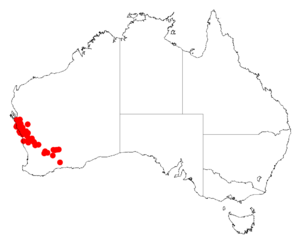Acacia signata facts for kids
Quick facts for kids Acacia signata |
|
|---|---|
| Scientific classification | |
| Genus: |
Acacia
|
| Species: |
signata
|
 |
|
| Occurrence data from AVH | |
Acacia signata is a special type of tree or shrub. It belongs to a large group of plants called Acacias. This plant is only found in western Australia, which means it is endemic there.
What Does Acacia signata Look Like?
This plant is usually a tall, slender tree or a bushy shrub. It often grows to be about 1 to 4 metres (3 to 13 ft) (3 to 13 feet) tall. Its branches often hang down or arch gracefully, and they can sometimes look like they're covered in a fine white powder.
Instead of regular leaves, Acacia signata has something called phyllodes. Phyllodes are flattened leaf stalks that act like leaves. These evergreen phyllodes usually hang down. They are long and narrow, either straight or slightly curved. They are a grey-green color and feel a bit leathery. Each phyllode is about 10 to 20 cm (3.9 to 7.9 in) (4 to 8 inches) long and 4 to 10 mm (0.16 to 0.39 in) (0.16 to 0.4 inches) wide. They have many thin veins and a noticeable yellow base called a pulvinus.
Acacia signata blooms from August to October. During this time, it produces bright yellow flowers. These flowers grow in groups of one to four spikes, which are shaped like cylinders. Each flower spike is about 12 to 23 mm (0.47 to 0.91 in) (0.5 to 0.9 inches) long and 6 to 7.5 mm (0.24 to 0.30 in) (0.24 to 0.3 inches) wide.
After the flowers, seed pods start to form. These pods are leathery and can be curved or straight. They have bumps where the seeds are. The pods can grow up to 7 cm (2.8 in) (2.8 inches) long and are 5 to 6 mm (0.20 to 0.24 in) (0.2 to 0.24 inches) wide. They are smooth and often have a powdery white coating. Inside, the seeds are shiny and dark brown. They are flat and roundish, about 4 to 4.5 mm (0.16 to 0.18 in) (0.16 to 0.18 inches) long, and are arranged lengthwise inside the pod.
How Was Acacia signata Named?
The first official description of Acacia signata was made in 1863. A botanist, which is a scientist who studies plants, named Ferdinand von Mueller described it. He published his findings in a book called Fragmenta Phytographiae Australiae.
Where Does Acacia signata Grow?
This plant naturally grows in the Mid West and the northern part of the Wheatbelt region of Western Australia. It often grows in sandy soils on flat, open areas called sandplains. You can find it in different plant communities like heathlands, scrublands, and shrublands. It grows from an area called Hamelin Pool in the north, down to Cockleshell Gully in the south, and as far east as Wubin. However, it is not a very common plant to find.

